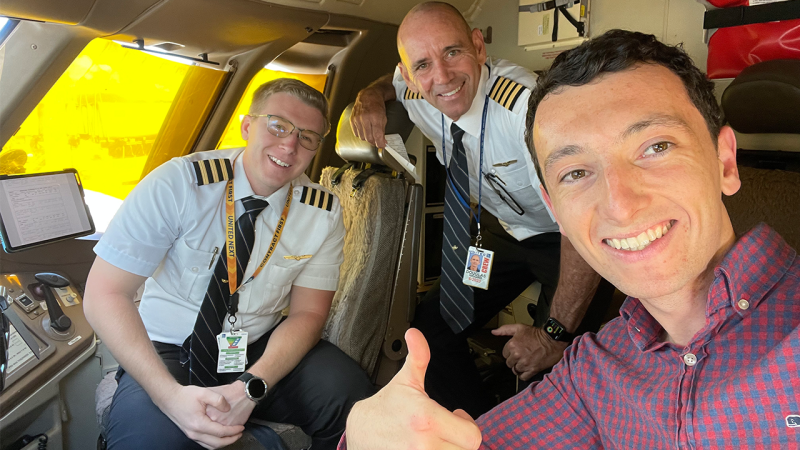Kyle Olsen/CNN Underscored
Travel products editor Kyle Olsen in the cockpit of a Boeing 777-300ER with two Denver-based United pilots
Air travel remains one of the safest and most widely utilized modes of transportation. After flying over 200,000 miles last year (and developing a frequent flyer packing list), I’ve encountered a plethora of passenger behaviors both in airports and aboard airplanes across the globe.
Regardless of your travel rewards, cabin class or travel credit cards, the privilege of flying comes with a responsibility to adhere to certain norms and practices that ensure a comfortable and safe journey for all passengers.
As we navigate the complexities of air travel in 2024, here are some essential do’s and don’ts to remember the next time you take to the skies.
Kyle Olsen/CNN Underscored
First class on an American Airlines Airbus A321
Arriving at the airport well in advance of your flight is crucial. Typically, the rule of thumb is two hours ahead of boarding for a domestic flight and three hours when flying internationally. This not only allows you to go through security and check-in procedures smoothly but also minimizes stress and potential delays.
Compliance with airport security regulations is non-negotiable. Although TSA PreCheck can simplify the screening process, be prepared to remove your shoes, belts and jackets and have your liquids and electronics easily accessible for screening. Respect the instructions of security personnel at all times.
Airplane cabins can be cramped, so it’s essential to be mindful of your fellow passengers’ personal space. Avoid leaning excessively into neighboring seats, hogging the armrest and refrain from sprawling out beyond your allotted area.
Flight attendants work tirelessly to ensure the comfort and safety of passengers. Show appreciation for their efforts by being polite, responsive and cooperative throughout the flight.
Overhead bin space is limited and shared, so be considerate when stowing your carry-on luggage. Place bags in the designated compartments with care, ensuring they can close.
If you have a second bag, place it under the seat in front of you. Once boarding has finished and if there’s still space, you can move your bag to the overhead.
While in-flight entertainment can enhance the travel experience, it’s essential to use headphones when listening to music, watching movies or playing games. This prevents unwanted sounds for others and ensures a quieter environment for those around you. Also, unless it’s an emergency, calls should be avoided on planes at all times.
If you bring snacks along with you, avoid strong-smelling foods that may cause discomfort to those nearby.
Airplane cabins have low humidity levels, which can lead to dehydration. Drink plenty of water throughout the flight to stay hydrated and refreshed.
If you’re able to, offer help to those in need, such as retrieving items from overhead bins for shorter or frail travelers.
Kyle Olsen/CNN Underscored
Economy class on an Alaska Airlines Boeing 737-900ER
While enjoying a drink or two may be acceptable for some, excessive alcohol consumption can lead to disruptive behavior and discomfort for fellow passengers. Drink responsibly and know your limits. And remember, you can’t consume your own alcohol on flights in the US.
Reclining your seat can encroach on the already limited space of passengers behind you. Before reclining, consider the impact it may have on those seated behind you, especially during meal times or when using electronic devices.
Look behind you before you recline your seat so you don’t accidentally crush another traveler’s laptop. And if want to be extra nice, consider not reclining your seat on short-haul daytime flights
Airplane cabins are not conducive to loud conversations or excessive noise. Be mindful of your volume when speaking to fellow passengers and avoid unnecessary disturbances, especially during designated rest times.
Any form of disruptive or unruly behavior, whether verbal or physical, is unacceptable. This includes arguments, aggressive language, gestures or actions that may compromise the safety and comfort of others on board. In addition to being rude, your antics may end up going viral.
Safety briefings and instructions provided by the flight crew are vital for passenger safety. Ignoring or disregarding these instructions poses a risk to yourself and others on board.
Limit the number of carry-on items you bring onto the plane to avoid cluttered overhead bins and cramped seating arrangements. Large or bulky items should be checked whenever possible to ensure ample space for all passengers.
Avoid occupying additional seats or spreading out belongings beyond your designated space. Be mindful of the comfort and convenience of fellow passengers, especially during peak travel times.
Wait your turn to exit the aircraft, allowing passengers with tight connections to deplane first.
Dispose of trash responsibly and clean up any messes to ensure a tidy environment for all onboard.
By adhering to these do’s and don’ts of passenger behavior, travelers can contribute to a more pleasant air travel experience for everyone on board.
Remember, practicing good etiquette not only enhances your own journey but also fosters of respect and consideration amongst travelers. It’s a win-win. Safe travels!
Looking for a travel credit card? Find out which cards CNN Underscored Money chose as the best travel credit cards currently available.










